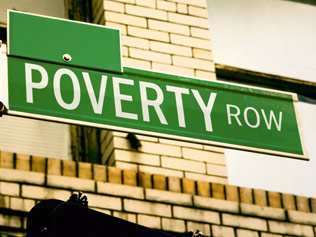Poverty Row was a slang term used in Hollywood from the late 1920s through the mid-1950s to refer to a variety of small (and mostly short-lived) B movie studios. While many of them were on (or near) today’s Gower Street in Hollywood, the term did not necessarily refer to any specific physical location, but was rather a figurative catch-all for low-budget films produced by these lesser-tier studios.
The films of Poverty Row, many of them Westerns (including series like “Billy The Kid” starring Buster Crabbe from PRC) or comedy/adventure series such as those featuring the Bowery Boys (Monogram Pictures) and detectives such as The Shadow, were generally characterized by low budgets, casts made up of lower ranked stars or unknowns, and overall production values that unintentionally betrayed the haste and economy with which they were made.
While some Poverty Row studios came and quickly went after a few releases, others operated on more or less the same terms as—if vastly different scales from—major film studios such as MGM, Warner Bros., and Paramount Pictures.
The most successful and longest-lived of such lower-tier companies maintained permanent lots (and many standing sets that dedicated moviegoers could frequently recognize from movie to movie), had both cast and crew on long-term contract, and had a more varied output than smaller firms.
From 1919 until its reorganization in 1924, Harry Cohn’s CBC Productions (later to become Columbia Pictures) was considered a Poverty Row studio.
Tiffany Pictures was in operation from 1921 through 1932 as both a production company (about 90 films) and a distributor.
Mascot Pictures was formed in 1927 by Nat Levine, and merged into Republic in 1935.
Larry Darmour Productions flourished from 1927 through the 1930s, mainly on the popularity of its Mickey McGuire short film series starring Mickey Rooney. Damour was also the principle producer within Majestic Pictures until 1935.
Monogram Pictures was created in 1931 by the merger of Sono Art-World Wide Pictures with W. Ray Johnston’s Rayart. After the attempted 1935 merger of Monogram into Republic, Johnston took Monogram independent again, and in the following decades produced everything from college/teen musicals starring popular swing bands to versions of classics like Oliver Twist and the final films of Kay Francis. It evolved, in relatively good financial condition, into Allied Artists in 1953.
Republic Pictures was organized in 1935 when Herbert J. Yates combined six other established poverty-row companies, Monogram, Mascot, Liberty, Majestic Pictures, Chesterfield, and Invincible with his Consolidated Film Laboratories. Republic began by releasing serial shorts and Westerns with Gene Autry in the 1930s before eventually riding the success of eventual superstar John Wayne and embarking on more ambitious projects, such as 1953’s Wayne hit, The Quiet Man.
Grand National Films Inc. was organized in 1936 with some significant talent (James Cagney and director Charles Lamont), but could not survive without its own distribution channel. It folded quickly in 1939, and released about 100 films altogether.
Producers Releasing Corporation emerged in 1939 and lasted until 1946, when it was absorbed into Eagle-Lion Films. PRC presented a steady output of westerns, serials, gangster movies, with occasional high spots, such as Edgar G. Ulmer’s Detour, and their 1944 Minstrel Man, nominated for two Academy Awards.
The smallest studios, including Tiffany Pictures, Sam Katzman’s Victory, Mascot and Chesterfield often packaged and released films from independent producers, British “quota quickie” films, or borderline exploitation films such as Hitler, Beast of Berlin to supplement their own limited production capacity.[citation needed] Sometimes the same producers would start a new studio when the old one failed, such as Harry S. Webb and Bernard B. Ray’s Reliable Pictures and Metropolitan Pictures.
Some organizations such as Astor Pictures and Realart Pictures began by obtaining the rights to re-release older films from other studios before producing their own films.
The breakup of the studio system (and its restrictive chain-theater distribution network, which left independent movie houses eager for seat-filling product from the Poverty Row studios) following 1948’s United States v. Paramount Pictures, Inc. decision and the advent of television are among the factors that led to the decline and ultimate disappearance of “Poverty Row” as a Hollywood phenomenon. While the kinds of films produced by Poverty Row studios only grew in popularity, they were increasingly available both from major production companies and from independent producers who no longer needed to rely on a studio’s ability to package and release their work.
The Big Five majors
Metro-Goldwyn-Mayer
Paramount Pictures
20th Century Fox
Warner Bros.
RKO Pictures
The Little Three majors
United Artists
Columbia Pictures
Universal Studios
Poverty Row
Grand National
Republic Pictures
Monogram Pictures
Producers Releasing Corporation (aka PRC)

